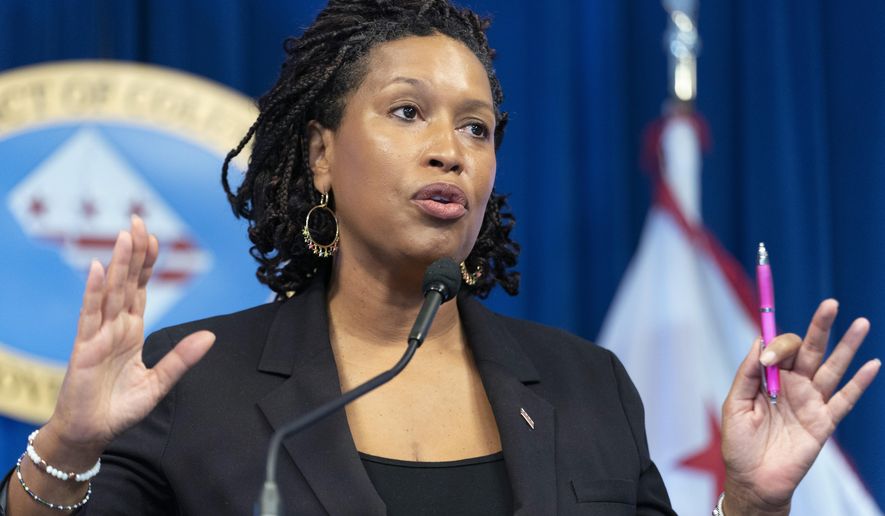A camera-monitoring hub that would give police real-time access to hundreds of live video feeds across the Washington area, including the Virginia and Maryland suburbs, is the latest law enforcement initiative rolled out by local officials struggling to stem a surge of crime in and around the nation’s capital.
D.C. Mayor Muriel Bowser and other officials who presented the Real-Time Crime Center plan on Thursday said facial recognition technology and artificial intelligence would not be used but declined to say how many personnel would be involved in monitoring the cameras.
Ms. Bowser said the center will be staffed 24 hours a day, year-round, inside the municipal Marion S. Barry Building when it becomes operational in February with a stated goal of streamlining police reactions to crime.
D.C. Metropolitan Police Chief Pamela Smith said the center will become “the nerve center” of law enforcement in the region.
“It will monitor and analyze data from various sources, including CCTV cameras, emergency calls and other technology products. Our ultimate goal is to enhance situational awareness, facilitate quick decision-making and improve the overall efficiency of our crime prevention and response efforts,” she said.
Nearly every law enforcement agency in the region is signing on to the crime center.
That includes federal police forces such as the U.S. Park Police, the U.S. Secret Service uniformed division and the U.S. Capitol Police. Local departments involved include Prince George’s County and Montgomery County in Maryland and Fairfax County and Arlington County in Virginia.
Metro and Amtrak police also have committed to working with the crime center, as have the U.S. Marshals Service, the Bureau of Alcohol, Tobacco, Firearms and Explosives, and the FBI.
The initiative is a response to the shootings, muggings and armed car thefts that have ravaged the District this year.
Metropolitan Police Department data shows violent crime is up 40%, largely from year-over-year jumps in homicides (up 32%), robberies (up 70%) and carjackings (up 107%).
Neighboring Prince George’s County has a 10% increase in violent crime, with a 6% increase in homicides and a 20% increase in robberies, including carjackings, according to police data.
The Big Brother-esque implications of police personnel having access to so many live camera feeds — an estimated 300 with plans to procure more — are far-reaching, but officials are under enormous pressure to rein in street crime.
Chief Smith said in her prepared remarks during the press conference Thursday that police will rely on reports from a victim or witness, not images captured on the cameras, before dispatching officers. She seemed to backpedal by telling a reporter that police won’t need to wait for a report if the crime center observes what appears to be a criminal act.
The privacy concerns related to the crime center have alerted some organizations about government interference with individual privacy.
“A center where police watch what people do in the District every hour of every day is an alarming expansion of government surveillance,” said Monica Hopkins, executive director of the D.C. chapter of the American Civil Liberties Union.
“With no oversight, the real-time surveillance center leaves serious questions about our safety and our rights unanswered. … What behavior will police be watching for? What will they do if they think they see it? How will police use what they see, and who will they share it with? And will anyone be there to ensure that police don’t violate people’s rights?” she said.
Chief Smith said no officers will be pulled from patrol duties to staff the crime center. The department counted 3,332 officers on Monday, the lowest number in half a century.
Chief Smith wouldn’t elaborate on who will run the crime center.
“I will not talk about staffing … and tactics with regards to the Real-Time Crime Center,” she said.
New York City launched its crime center in 2005. Other major cities such as Newark, New Jersey, and Atlanta followed suit. Smaller jurisdictions, including Hampton, Virginia, and Pasco County, Florida, also have Real-Time Crime Centers.
Police abuses of the technology have been documented.
Pasco County was the subject of a 2020 investigative report from the Tampa Bay Times that found the sheriff’s office harassed people it deemed “likely to break the law.”
The publication reported that a list of people was compiled based on “arrest histories, unspecified intelligence and arbitrary decisions by police analysts.”
The newspaper reported that deputies would be sent to “find and interrogate anyone whose name appears, often without probable cause, a search warrant or evidence of a specific crime.”
On Thursday, Chief Smith suggested collaboration among RTCC-participating agencies could help investigate suspects who crisscross jurisdictions.
D.C. police said they arrested 16-year-old Ashton Inabinet on Tuesday in Alexandria, Virginia. The boy was charged with murder in the District in connection with a deadly October shooting in Northwest.
The chief said having a functioning crime center would help “tighten up” all kinds of investigations.
• Matt Delaney can be reached at mdelaney@washingtontimes.com.




Please read our comment policy before commenting.